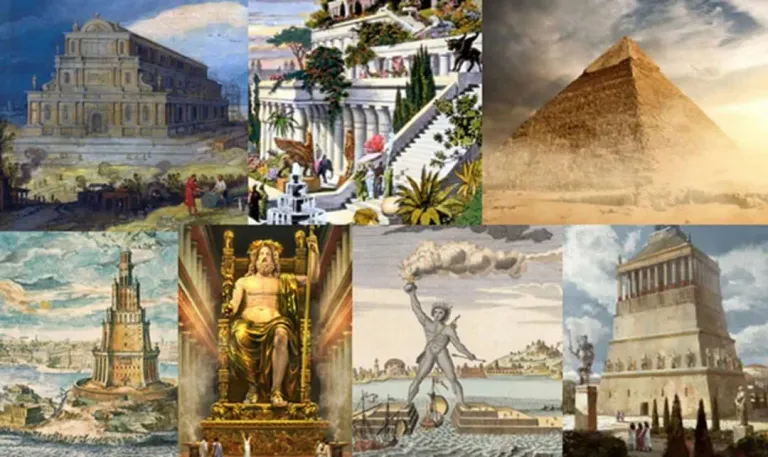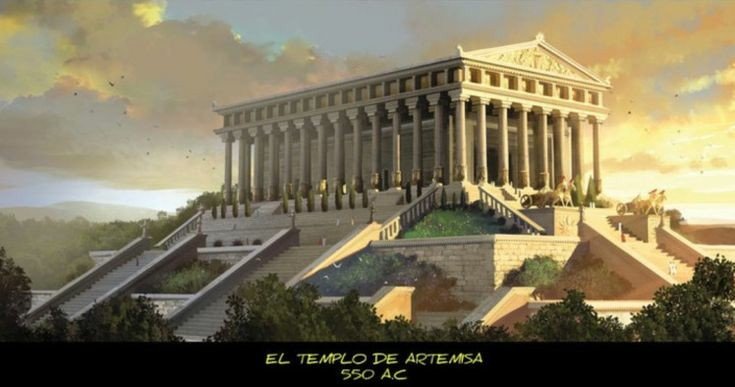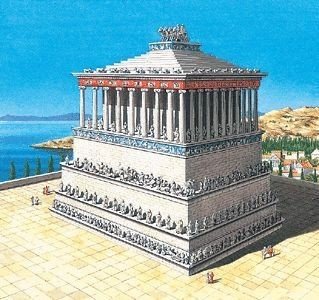
Fuente
Título: Manifestaciones del ingenio humano: las siete maravillas del mundo antiguo. (III Parte) Por Florencia Renata.
Aviso: pueden leer las anteriores entregas en los siguientes enlaces:

Fuente
Templo de Artemisa, Éfeso, actual Turquía
La diosa Artemisa era para los griegos la cazadora, y la imaginaban solitaria, hermosa, casta y pura, razón por la que se le relacionaba con la Luna. En varias partes de Grecia se le rendía culto como la diosa lunar, pero fue Creso, rey de Lidia, quien ordenó la construcción de su templo alrededor del año 550 a.C, en la ciudad de Éfeso.
El templo tenía 127 columnas, sobre una superficie de 73 por 141 metros, guardaba algunas de las mejores obras del arte griego, de las que sólo quedan algunas copias de la estatua de la diosa Artemisa. Incendiado en el año 356 a.C, fue reconstruido en su antiguo emplazamiento por el arquitecto griego Dinocrates, sin embargo los godos destruyeron definitivamente el templo en el año 262 de nuestra era. Se conservan algunos fragmentos de sus paredes en el Museo Británico de Londres.

Fuente
Mausoleo de Halicarnaso,actual Turquía:
En el siglo IV antes de J.C, existió al noroeste de Asia Menor una región llamada Caria, que contaba con dos ciudades más importantes: Mileto y Halicarnaso. El monarca de Caria era Mausolo y su mujer, llevaba por nombre Artemisa. Fue ella quien, para cumplir los deseos de Mausolo una vez que éste falleció, mandó a construir una tumba monumental, en el año 353 a.C; siendo obra de un arquitecto de nombre Phytheos.
El sepulcro o mausoleo*, constaba de tres cuerpos, coronado con una cuádriga con las estatuas de Mausolo y Artemisa. Medía 42 metros de alto. En el siglo IV de nuestra era fue arrasado por los turcos.
En el Museo Británico se conservan algunos frisos de las batallas de los griegos y las amazonas y una estatua de aproximadamente 3 metros, que probablemente corresponda a Mausolo.
*Nota: Mausoleo proviene del nombre Mausolo, y es el nombre que recibe todo sepulcro suntuoso.
Continuará…

Fuente
Title: Manifestations of human ingenuity: the seven wonders of the ancient world. (Part III) By Florencia Renata.

Fuente
Temple of Artemis, Ephesus, present-day Turkey
The goddess Artemis was for the Greeks the hunter, and they imagined her lonely, beautiful, chaste and pure, which is why she was related to the Moon. In various parts of Greece she was worshiped as the lunar goddess, but it was Croesus, king of Lydia, who ordered the construction of her temple around 550 BC, in the city of Ephesus.
The temple had 127 columns, on an area of 73 by 141 meters, it housed some of the best works of Greek art, of which only a few copies of the statue of the goddess Artemis remain. Burned down in 356 BC, it was rebuilt on its former site by the Greek architect Dinocrates, however the Goths definitively destroyed the temple in the year 262 AD. Some fragments of its walls are preserved in the British Museum in London.

Fuente
Mausoleum of Halicarnassus, present-day Turkey:
In the fourth century BC, there existed in the northwest of Asia Minor a region called Caria, which had two most important cities: Miletus and Halicarnassus. The monarch of Caria was Mausolus and his wife was named Artemis. It was she who, to fulfill the wishes of Mausolus once he died, ordered to build a monumental tomb, in the year 353 BC; being the work of an architect named Phytheos.
The sepulchre or mausoleum*, consisted of three bodies, crowned with a quadriga with the statues of Mausolus and Artemis. He was 42 meters tall. In the IV century of our era it was razed to the ground by the Turks.
In the British Museum there are preserved some friezes from the battles of the Greeks and the Amazons and a statue of about 3 meters, which probably corresponds to Mausolus.
*Note: Mausoleum comes from the name Mausolo, and is the name given to every sumptuous tomb.
Continue...
Yay! 🤗
Your content has been boosted with Ecency Points
Use Ecency daily to boost your growth on platform!
Support Ecency
Vote for new Proposal
Delegate HP and earn more, by @c1udadan0x.